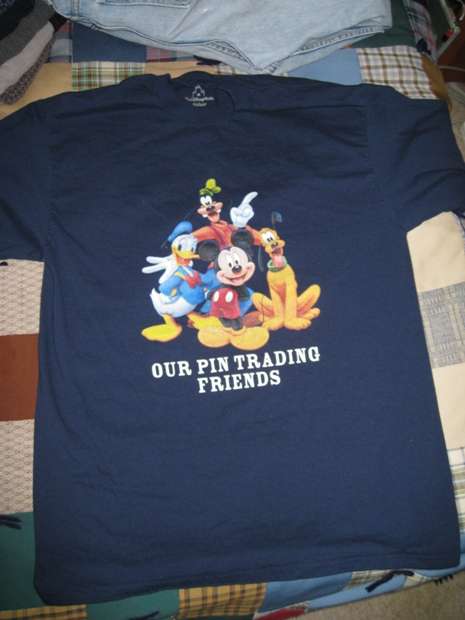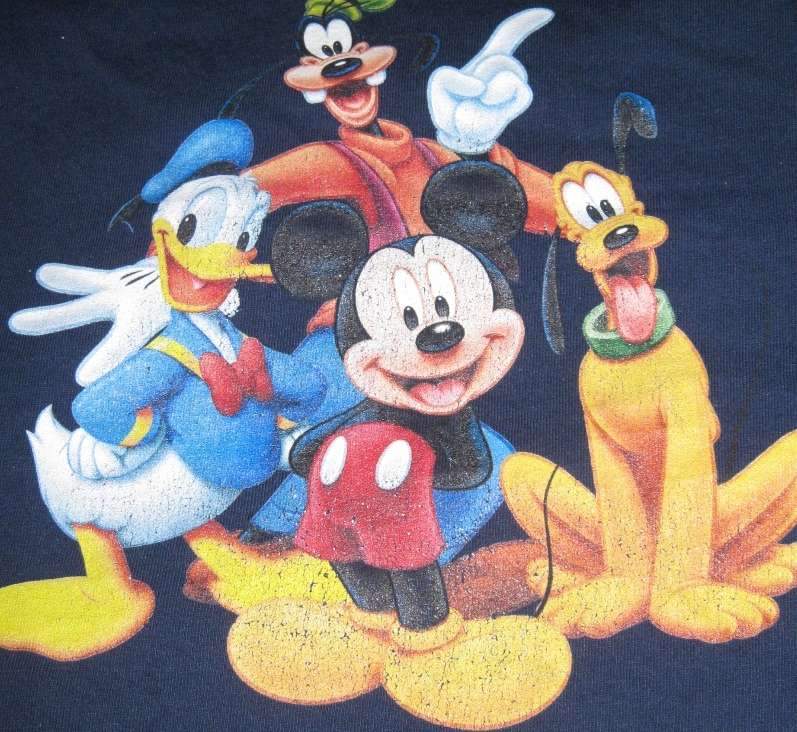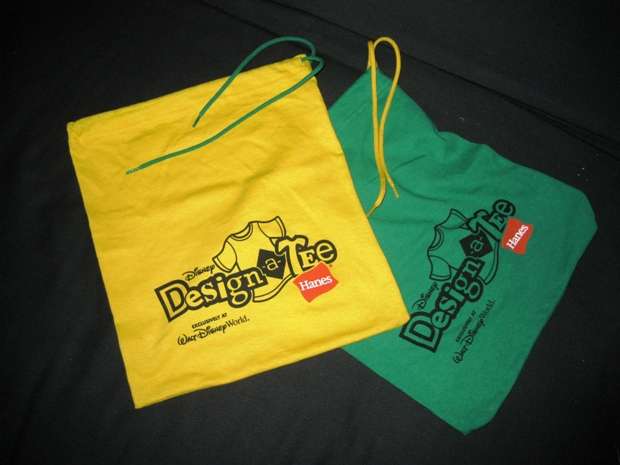However, this is.
The quality of the printed images on the t-shirts SUCKS! After just ONE WASH, the images are starting to show cracks and peels. The picture below shows the t-shirt:

.. and this is a close-up picture of the image on the t-shirt. There were no cracks or peeling when it was brand new.

And yes, I did wash it inside-out, if you want to know.
These occurs for BOTH t-shirts that I bought. Now these are not cheap t-shirts. I think I paid $24.99 for short sleeve and $29.99 for long sleeve (I'm reciting this off the top of my head so I may be off, but those are the ball-park numbers). So for that money, one would expect something that can last at least a few washings! In fact, I kinda expected something of the quality that one would get with other Disney t-shirts one buys at other Disney stores. I don't think that's an unreasonable expectation.
So that's disappointing. I would not buy any more shirts from that store, and I certainly would not recommend anyone to buy their custom-designed shirts there. While the experience was definitely fun, the quality of the merchandise is truly disappointing.
BTW, when you buy a t-shirt there, your t-shirt comes in a cloth bag that I think is very cool. It certainly looks like it is better printed than the t-shirt itself!

It's too bad that they didn't put as much quality control in the t-shirt print as they did with the cloth bags!
Zz.
12 comments:
Found you via the Disney Blog...
Thanks for the Design-a-Tee review. We leave on Saturday, and our plan was to hit DtD for two shirts (for autographs) that night. I'm thinking now that a $5 tee from the Disney store is a much better investment!
Janna
I would really like to know the process of the print, if possible. Is it screen printed or a heat transfer pressed onto the shirt.
Thanks
I agree. My son was very disappointed and said, "Mom what did we do wrong?" A lot of money to wear twice.
I did some research, and found an article that helps explain the problems. I guess Disney just needs to use more ink. This is all assuming that they are screen printed, of course.
"Fibrillation occurs when a garment's cotton fibers break through the ink film's surface, creating a washed-out, "hairy" look due to the color contrast of the ink and the fiber. Although the problem usually begins when ink isn't applied thickly enough to encapsulate the garment's fibers, it isn't revealed until the end customer washes the garment, explains Steve Hedge, Techincal Service Manager for PolyOne/Wilflex.
"The natural adhesion characteristics of plastisol and cotton are not such that they bond strongly," he says. "And any time there's a high contrasting color between the ink and the shirt-like red on a white T-shirt-the fibrillation is very obvious to the eye. If you have yellow ink on a white shirt, it's negligible."
Also, Hedge says, the washed-out look isn't the fault of the ink washing out. If that were the case, the print would look faded in a random manner rather than fairly consistently throughout the design, as is the case with fibrillation.
Fibrillation Factors
Ironically, as the screen printing process has improved resulting in a print with a softer hand, the problem of fibrillation has increased. As printers put less ink on 100% cotton garments to get a soft hand, they decrease the "mat down" of the shirt's fibers and increase the likelihood of problems. "It's become more predominant in recent years because people are printing with such fine mesh counts," Hedge says.
Another irony is that fibrillation is actually more likely to occur on a higher-quality garment than a cheap one, according to industry consultant Charlie Taublieb, owner, Taublieb Consulting, Englewood, Colo. "If the shirt is cheap enough, there isn't even enough fiber there to stand up," he explains. "Then when the printer goes to a better shirt, he goes nuts because he doesn't know how to handle it."
The problem also is more likely to rear its head during true process jobs, Taublieb says. "You're putting down such a thin ink deposit with process work," he says. "Anytime you're going with a thin deposit of dark ink on a light-colored shirt, you're going to have issues. With process work, you're looking for rich colors, and fibrillation kills the contrast. So it's not that fibrillation doesn't affect spot jobs, too; it's just that it's more objectionable on a process job."
Fibrillation is less of a noticeable problem with dark shirts, Taublieb adds, where fibers that may pop through are difficult to see. "It doesn't matter on a black shirt. Even if the fibers stand up, black fiber will continue to appear black," he says. "Also, when you're printing on darks, you're using a heaver mesh count and more opaque ink."
Fibrillation Solutions
Unfortunately, fibrillation isn't the type of problem that has a single, clear-cut solution, due to the variety of variables involved, including garment type and brand, and ink type and brand. For instance, some inks designed for high-speed automatic printing have less opacity and fillers, while athletic ink may have more fillers. (More fillers translate to better mat down.)
Curing also plays a role, with an under-cured film less likely to fully mat down fibers, says Claude Rainford, senior research chemist, Union Ink, Ridgefield, N.J. "One of the things you can do is increase your temperatures or slow down your dryer belt," he says.
More ink. Kitson has found a simple solution, at least for his athletic customers. He does things the "old-fashioned" way: more ink. "We have regressed, and we're putting down a lot more ink and doing lots of flashing. We've created a price list for athletic printing that assumes everything will be print/flash/print," he says. "Red on white, black on white, pink on green-everything gets a print/flash/print."
Many customers actually prefer this traditional athletic print over the soft-hand print, Kitson says, prompting him to change from 175 and 140 mesh to 110 and 94. "With one customer, we said, "We're going to charge you 13% more, and we're going to lay down a lot of ink, like the old Russell Athletic tire prints," Kitson says. "And they've been extremely happy."
Clear coatings. Even for nonathletic customers, Kitson uses a thicker ink deposit, often flashing the first color to encapsulate the fibers. And depending on a job's requirements, he may print either a clear underbase or top coating. Precise registration isn't required with a clear top coating, he says, making the job easier to deal with. "If your registration isn't 100%, you can get away with it, especially if you're printing something with a halftone fade," Kitson says. "The dots don't have to match."
Hedge agrees that putting down a clear underbase and then printing on top of that can solve many fibrillation woes. "For spot printing, that's one of the better solutions," he says. "But if you're doing process printing, you don't want to do that because you're putting flash on top of flash. You're better off printing everything and then putting a clear topcoat to lock the fibers in place."
The overprint, which should be applied with a 205 mesh, doesn't add much to the hand, Hedge says. "There may still be some issues, but it helps extend the life of the print," he explains. "If you're looking for something that lasts 50 washes, this isn't going to do it."
More suggestions. Hedge also suggests trying a fast-fusion, low-curing ink that stands up to abrasion and washing better than other inks. However, this ink has a glossier look and a tacky feel that clients may find undesirable. Additives for plastisol ink also are available to improve adhesion, he says."
Extracted from U.S. Screen Print and Inkjet Technology
Hi ZapperZ -
I work for a company that designs and manufactures Screen printing equipment - I saw your post while searching for something related to fibrillation, and thought I'd chime in.
You're very close on your investigation - the effects you are seeing are similar to the problem of fibrillation that occurs when screen printing t-shirts with plastisol based inks, although it is rarely as severe as your image shows. Disney isn't using a traditional plastisol screen printing process in the Design-a-Tee stores - they are using a newer technology called direct-to-garment (DTG) printing, which uses an adapted version of inkjet printing to directly print designs from a computer onto a garment or other textile product. In this case, the problems you are seeing relate to the improper pre-treatment of the fabric before printing. The white inks used in DTG printing require a catalyst to cause the ink to adhere correctly to the fibers of the shirt and provide a white/opaque surface for the colored inks. When that pretreatment is applied too thinly or too heavily, the ink is unable to adhere correctly to the cotton fibers in the shirt because it either fails to gel at all or -in the case of a heavy application- fails to penetrate the fabric, gelling on the surface. When the white ink gels on the surface of the shirt, it provides an excellent surface for the colored inks, but typically washes out in varying degrees and irregular patterns. In your case, you are seeing the results of a pretreatment application that was too heavy. Unfortunately, it is difficult for a consumer to discern this at the point of purchase without a wash-test. In situations where you are traveling and won't have the opportunity to return the shirt if this problem occurs after washing, I'd recommend purchasing designs printed on white shirts, as they require no pre-treatment or white ink layer at all. The colored inks print directly on the white fabric and saturate the cotton fibers, essentially dying the shirt with the design. While the design on white may fade subtly with time and washing, it won't crack or lift from the shirt and it should last as long or longer than a screen-printed design. If you really want a dark or colored shirt and you're staying at the park for several days and have the opportunity to take the shirt back to your hotel room, you could wash it vigorously in the bathroom sink, or bathtub - if the design starts to lift from the shirt, you could then return it to the store and request a refund.
Joe Abreu
Multimedia Director
M&R Sales and Service, Inc.
Joe,
Thank you very much for your comment, and your suggestion.
I'm hoping that there are people who have bought this recently and can let me know if the problem still persists, or if the store has made any adjustments and changes to reduce this problem. I certainly would not be buying any more t-shirts until I hear otherwise.
But with your suggestion of having it printed on white t-shirts might be the temporary solution to this if I do end up wanting another t-shirt from there.
Zz.
We got one just last week and it did the same thing after the first wash.
That's what happened to my boyfriend's shirt I bought him a year and half ago. Fortunately for me being a cast member I bought this when we get a 50% discount on merchandise (around the holidays) b/c I would never pay regular price (like this) for a shirt. I'm headed back down soon and want to get a matching shirt (he has Bob from Incredible's...it's funny b/c my bf's name is Bob too, lol!) and I was hoping they have Mrs. Incredible but I'm not sure they do...we'll see! Thanks for the suggestion of the white shirt..if I find it I'll have to try it. Thanks for the blog post!
I just got back from Disney last week and my sons both got shirts from there. One has done ok but the other is cracking and peeling. My son was so disappointed! I emailed them but haven't heard back. I waited 72 hours to wash and washed in cold water inside out. Then I hung it up to air dry. Not happy at all that a $25 shirt/keepsake lasting through one wash!!!!!
I am so disappointed! We just bought three of these tshirts on our trip to Disney in November and both mine and my husbands look AWFUL and we followed the care instructions to a "t" and even waited over two weeks before we washed them. What a waste of money but more important to me, we picked shirts to commemorate our first trip to Disney and our 7 year wedding anniversary. What more bizarre though is that my daughter's tshirt is perfectly fine.
And I think we're definitely seeing that it is quite inconsistent here. This is another reason that I definitely won't be buying any more of such T-shirts in the future.
It's silly that after a couple of years, they can't get this right already.
Zz.
I have been told by friends who make tee shirts to ALWAYS put a store bought shirt in the dryer for 20-30 minutes(inside out) to help complete the drying of the print. This will help to keep it from happening so quickly.
Post a Comment